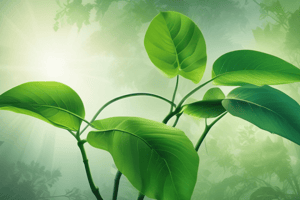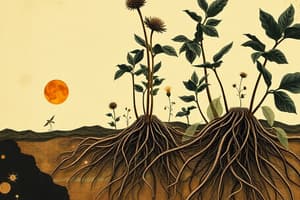Podcast
Questions and Answers
What are five features of all plants that separate them from algae and reflect their adaptation to life on land?
What are five features of all plants that separate them from algae and reflect their adaptation to life on land?
Five features include alternation of generations, protection of gametes and spores, apical meristems, eukaryotic nature, and photosynthetic autotrophs with cell walls.
What are the three phyla of non-vascular plants represented by small herbaceous plants?
What are the three phyla of non-vascular plants represented by small herbaceous plants?
- Liverworts
- Hornworts
- Mosses
- All of the above (correct)
Non-vascular plants like bryophytes have specialized conductive tissues to transport water and nutrients.
Non-vascular plants like bryophytes have specialized conductive tissues to transport water and nutrients.
False (B)
Plants alternate between two multicellular stages in a cycle known as __________ of __________.
Plants alternate between two multicellular stages in a cycle known as __________ of __________.
List 2 advantages of moving onto land for plants.
List 2 advantages of moving onto land for plants.
What are the special organs for gamete production in plants?
What are the special organs for gamete production in plants?
Non-vascular plants have specialized conductive tissues.
Non-vascular plants have specialized conductive tissues.
Bryophytes are represented today by three phyla of small herbaceous plants: Liverworts (phylum Hepatophyta), Hornworts (phylum Anthocerophyta), and ________ (phylum Bryophyta)
Bryophytes are represented today by three phyla of small herbaceous plants: Liverworts (phylum Hepatophyta), Hornworts (phylum Anthocerophyta), and ________ (phylum Bryophyta)
What is the function of sclerenchyma cells in plants?
What is the function of sclerenchyma cells in plants?
Where in the plant do sclerenchyma cells occur?
Where in the plant do sclerenchyma cells occur?
Sclerenchyma cells can elongate like collenchyma cells. (True/False)
Sclerenchyma cells can elongate like collenchyma cells. (True/False)
Many sclerenchyma cells are dead, but their thick cell wall remains as a 'skeleton' to support the organ. This thick cell wall is rich in ___________.
Many sclerenchyma cells are dead, but their thick cell wall remains as a 'skeleton' to support the organ. This thick cell wall is rich in ___________.
Which of the following is NOT a basic organ of a plant?
Which of the following is NOT a basic organ of a plant?
What are the three basic plant organs?
What are the three basic plant organs?
What is the main function of roots in plants?
What is the main function of roots in plants?
Leaves are the main photosynthetic organ of most vascular plants.
Leaves are the main photosynthetic organ of most vascular plants.
What are the two vascular tissues responsible for long-distance transport in plants?
What are the two vascular tissues responsible for long-distance transport in plants?
______ tissues form the protective covering of a plant.
______ tissues form the protective covering of a plant.
Match the following ground tissues with their functions:
Match the following ground tissues with their functions:
Flashcards are hidden until you start studying
Study Notes
Plant Diversity I: Non-vascular and Seedless Vascular Plants
Origin and Phylogeny of Land Plants
- Land surface was largely lifeless for the first 3 billion years.
- Cyanobacteria existed on land around 1.2 billion years ago.
- Small plants, fungi, and animals emerged on land around 500 million years ago.
- There are now approximately 290,000 living species of plants.
Colonizing Land
- Moving from water to land had advantages: bright sunlight, more CO2 in air, soil rich in mineral nutrients, and less competition.
- However, it also posed challenges: scarcity of water and lack of structural support against gravity.
- Plants' diversity reflects different adaptations to these challenges.
Special Adaptations of Land Plants
- Land plants alternate between two multicellular stages: multicellular haploid and multicellular diploid organisms.
- Gametes, zygotes, and spores are protected: specialized organ for gamete production, multicellular dependent embryos, and tough and protected spores.
- Plants need to grow above and below ground, which led to the development of apical meristems.
Kingdom: Plantae
- Plants are photosynthetic organisms that have adapted to life on land, are eukaryotes, have cell walls, and are photosynthetic autotrophs.
- Life on land owes its existence to plants, which live in all but the harshest terrestrial habitats.
- There are two distinct forms of plants: vascular and non-vascular plants.
Non-vascular Plants
- Non-vascular plants (bryophytes) are primitive land plants with simple structures that require an abundance of water.
- They lack specialized conductive tissues and are represented by three phyla: Liverworts (Hepatophyta), Hornworts (Anthocerophyta), and Mosses (Bryophyta).
- There are approximately 9000 species of liverworts, which are usually small.
Biological Systems - Module 5 (Lecture 5.1)
Origin and Phylogeny of Land Plants
- For the first 3 billion years, the land surface was largely lifeless
- Cyanobacteria existed on land ≈1.2 billion years ago
- Small plants, fungi, and animals emerged on land ≈500 million years ago
- Now, there are ≈290,000 living species of plants
Adaptations of Land Plants
- Plants have adapted to life on land, with features such as:
- Alternation of generations, including multicellular haploid and diploid organisms
- Protection of gametes, zygotes, and spores
- Specialized organs for gamete production (gametangia)
- Multicellular, dependent embryos (“embryophytes”)
- Tough and protected spores with walls resistant to drying
- Apical meristems, allowing growth above and below ground
Kingdom: Plantae
- Plants are photosynthetic organisms that have adapted to life on land
- They are eukaryotes, have cell walls, and are photosynthetic autotrophs
- They produce their own food using sunlight, and have adapted to live in all but the harshest terrestrial habitats
Non-Vascular Plants (Bryophytes)
- Non-vascular plants are primitive land plants with simple structures
- They need an abundance of water and lack specialized conductive tissues
- They are represented by three phyla: Liverworts (Hepatophyta), Hornworts (Anthocerophyta), and Mosses (Bryophyta)
Characteristics of Non-Vascular Plants
- Bryophytes are small, herbaceous, and non-woody plants
- They have no roots, only simple rhizoids
- They reproduce by producing spores
- They need a film of water for fertilization and reproduction
Plant Organisation
- Plants are composed of cells, tissues, and organs.
- A cell is the fundamental unit of life.
- A tissue is a group of cells consisting of one or more cell types that together perform a specialised function.
- An organ consists of several types of tissues that together carry out particular functions.
Hierarchical Organisation in Plants
- Basic morphology reflects evolution as organisms that draw resources from below ground and above ground.
- Plants have three basic organs:
- Roots: anchor, absorb water and minerals, and store products of photosynthesis (sugars).
- Stems: elongate and orient shoot for optimal photosynthesis; elevate reproductive structures.
- Leaves: produce sugars by photosynthesis; exchange gases; dissipate heat.
Plant Organs
- Roots:
- Functions: anchor, absorb minerals and water, store carbohydrates and other reserves.
- Most eudicots and gymnosperms have taproot systems.
- Most monocots have fibrous root systems.
- Stems:
- Functions: elongate and orient shoot to maximise photosynthesis; elevate reproductive structures.
- Consist of alternating nodes and internodes.
- Most growth in young shoots is concentrated in the shoot tip (apical bud).
- Leaves:
- Main photosynthetic organ of most vascular plants.
- Generally consist of a flattened blade and a stalk (petiole).
- May be simple (undivided blade) or compound (leaf divided into leaflets).
Plant Tissues
- 3 basic tissue systems:
- Dermal tissues: protective covering of the plant.
- Vascular tissues: conduct water, minerals, and food.
- Ground tissues: the bulk of the plant.
Dermal Tissues
- Surface of the plant is covered in a continuous layer of tightly packed cells (epidermis).
- Specialised characteristics in each organ:
- Roots: enhance water and mineral uptake.
- Stem and leaves: protect against water loss.
- Leaves: increase gas exchange through stomata.
Vascular Tissues
- Conduct long-distance transport of materials between roots and shoots.
- Two vascular tissues are xylem and phloem.
- Xylem:
- Transports water and dissolved minerals upward from roots into shoots.
- Dead (functioning) cells.
- Phloem:
- Transports sugars (products of photosynthesis) from where they are made to where they are needed or stored.
- Alive cells with pores on sidewalls.
Ground Tissues
- Anything that isn't vascular or dermal is ground tissue.
- Not just filler: includes specialized cells for functions such as:
- Storage
- Photosynthesis
- Support
- Short-distance transport
- 3 types of cells:
- Parenchyma: soft tissue, metabolic functions, alive.
- Collenchyma: flexible structural support, alive.
- Sclerenchyma: strong structural support, mostly dead cells ("skeleton").
Wrapping Up
- Summary of what we learned about plant organisation, organs, and tissues.
Studying That Suits You
Use AI to generate personalized quizzes and flashcards to suit your learning preferences.





